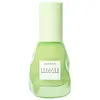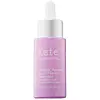What's inside
What's inside
 Key Ingredients
Key Ingredients

 Benefits
Benefits

 Concerns
Concerns

 Ingredients Side-by-side
Ingredients Side-by-side

Water
Skin ConditioningGlycerin
HumectantJojoba Esters
EmollientPersea Gratissima Oil
Skin ConditioningPersea Gratissima Fruit Extract
EmollientNiacinamide
SmoothingCeramide NP
Skin ConditioningCeramide Ns
Skin ConditioningCeramide AP
Skin ConditioningCeramide EOP
Skin ConditioningCeramide Eos
Skin ConditioningHydrolyzed Rice Protein
Skin ConditioningAllantoin
Skin ConditioningOryza Sativa Bran Oil
EmollientBisabolol
MaskingZingiber Officinale Root Extract
MaskingCurcuma Longa Root Extract
MaskingTocopherol
AntioxidantPalmitoyl Tripeptide-8
Skin ConditioningVitis Vinifera Fruit Extract
Skin ConditioningPotassium Palmitoyl Hydrolyzed Wheat Protein
CleansingBoswellia Serrata Extract
Skin ConditioningPopulus Tremuloides Bark Extract
AntiseborrhoeicCaprylic/Capric Triglyceride
MaskingSodium Phytate
Cetyl Alcohol
EmollientMelia Azadirachta Flower Extract
Skin ConditioningMelia Azadirachta Leaf Extract
Skin ConditioningOcimum Sanctum Leaf Extract
Skin ConditioningBehenic Acid
CleansingCholesterol
EmollientEthylhexylglycerin
Skin ConditioningOcimum Basilicum Flower/Leaf Extract
TonicElettaria Cardamomum Seed Extract
PerfumingJasminum Officinale Flower/Leaf Extract
MaskingCorallina Officinalis Extract
Skin ConditioningSodium Carbonate
BufferingSodium Chloride
MaskingCI 75810
Cosmetic ColorantCamellia Sinensis Leaf Extract
AntimicrobialCananga Odorata Flower Extract
PerfumingCaprooyl Phytosphingosine
Skin ConditioningCaprooyl Sphingosine
Skin ConditioningCucumis Melo Fruit Extract
Skin ConditioningCucumis Sativus Fruit Extract
EmollientPyrus Malus Fruit Extract
Skin ConditioningRose Extract
Skin ConditioningRubus Idaeus Leaf Extract
Skin ConditioningAscorbyl Palmitate
AntioxidantDextran
Hydroxyacetophenone
AntioxidantXanthan Gum
EmulsifyingButylene Glycol
HumectantCarbomer
Emulsion StabilisingCetearyl Olivate
Sorbitan Olivate
Emulsifying1,2-Hexanediol
Skin ConditioningCaprylyl Glycol
EmollientHydrogenated Vegetable Oil
EmollientLavandula Angustifolia Flower/Leaf/Stem Extract
MaskingSantalum Album Wood Extract
PerfumingTocopheryl Acetate
AntioxidantCeteareth-25
CleansingSodium Hydroxide
BufferingPhenoxyethanol
PreservativeSodium Benzoate
MaskingWater, Glycerin, Jojoba Esters, Persea Gratissima Oil, Persea Gratissima Fruit Extract, Niacinamide, Ceramide NP, Ceramide Ns, Ceramide AP, Ceramide EOP, Ceramide Eos, Hydrolyzed Rice Protein, Allantoin, Oryza Sativa Bran Oil, Bisabolol, Zingiber Officinale Root Extract, Curcuma Longa Root Extract, Tocopherol, Palmitoyl Tripeptide-8, Vitis Vinifera Fruit Extract, Potassium Palmitoyl Hydrolyzed Wheat Protein, Boswellia Serrata Extract, Populus Tremuloides Bark Extract, Caprylic/Capric Triglyceride, Sodium Phytate, Cetyl Alcohol, Melia Azadirachta Flower Extract, Melia Azadirachta Leaf Extract, Ocimum Sanctum Leaf Extract, Behenic Acid, Cholesterol, Ethylhexylglycerin, Ocimum Basilicum Flower/Leaf Extract, Elettaria Cardamomum Seed Extract, Jasminum Officinale Flower/Leaf Extract, Corallina Officinalis Extract, Sodium Carbonate, Sodium Chloride, CI 75810, Camellia Sinensis Leaf Extract, Cananga Odorata Flower Extract, Caprooyl Phytosphingosine, Caprooyl Sphingosine, Cucumis Melo Fruit Extract, Cucumis Sativus Fruit Extract, Pyrus Malus Fruit Extract, Rose Extract, Rubus Idaeus Leaf Extract, Ascorbyl Palmitate, Dextran, Hydroxyacetophenone, Xanthan Gum, Butylene Glycol, Carbomer, Cetearyl Olivate, Sorbitan Olivate, 1,2-Hexanediol, Caprylyl Glycol, Hydrogenated Vegetable Oil, Lavandula Angustifolia Flower/Leaf/Stem Extract, Santalum Album Wood Extract, Tocopheryl Acetate, Ceteareth-25, Sodium Hydroxide, Phenoxyethanol, Sodium Benzoate
Water
Skin ConditioningGlycerin
HumectantHydrolyzed Yeast Protein
Skin ConditioningButylene Glycol
HumectantPropanediol
SolventCucumis Sativus Seed Oil
EmollientEctoin
Skin ConditioningHydroxyectoin
BufferingCeramide NP
Skin ConditioningCeramide AP
Skin ConditioningCeramide EOP
Skin ConditioningPalmitoyl Tripeptide-8
Skin ConditioningTasmannia Lanceolata Fruit Extract
Skin ConditioningHippophae Rhamnoides Oil
EmollientTocopherol
AntioxidantCholesterol
EmollientEthylhexylglycerin
Skin ConditioningCarbomer
Emulsion StabilisingAspergillus/Molasses Ferment Filtrate
Skin ConditioningPhytosphingosine
Skin ConditioningAdenosine
Skin ConditioningCaprylhydroxamic Acid
Xanthan Gum
Emulsifying1,2-Hexanediol
Skin ConditioningGlycine Soja Extract
Skin ConditioningLecithin
EmollientSclerotium Gum
Emulsion StabilisingPullulan
Dextran
Pentylene Glycol
Skin ConditioningSodium Lauroyl Lactylate
EmulsifyingDisodium EDTA
Silica
AbrasiveSodium Benzoate
MaskingPhenoxyethanol
PreservativeWater, Glycerin, Hydrolyzed Yeast Protein, Butylene Glycol, Propanediol, Cucumis Sativus Seed Oil, Ectoin, Hydroxyectoin, Ceramide NP, Ceramide AP, Ceramide EOP, Palmitoyl Tripeptide-8, Tasmannia Lanceolata Fruit Extract, Hippophae Rhamnoides Oil, Tocopherol, Cholesterol, Ethylhexylglycerin, Carbomer, Aspergillus/Molasses Ferment Filtrate, Phytosphingosine, Adenosine, Caprylhydroxamic Acid, Xanthan Gum, 1,2-Hexanediol, Glycine Soja Extract, Lecithin, Sclerotium Gum, Pullulan, Dextran, Pentylene Glycol, Sodium Lauroyl Lactylate, Disodium EDTA, Silica, Sodium Benzoate, Phenoxyethanol
 Reviews
Reviews

Ingredients Explained
These ingredients are found in both products.
Ingredients higher up in an ingredient list are typically present in a larger amount.
1,2-Hexanediol is a synthetic liquid and another multi-functional powerhouse.
It is a:
- Humectant, drawing moisture into the skin
- Emollient, helping to soften skin
- Solvent, dispersing and stabilizing formulas
- Preservative booster, enhancing the antimicrobial activity of other preservatives
Butylene Glycol (or BG) is used within cosmetic products for a few different reasons:
Overall, Butylene Glycol is a safe and well-rounded ingredient that works well with other ingredients.
Though this ingredient works well with most skin types, some people with sensitive skin may experience a reaction such as allergic rashes, closed comedones, or itchiness.
Learn more about Butylene GlycolCarbomer is a polymer of acrylic acid. Its main role is to create a gel consistency.
A high amount of carbomer can cause pilling or balling up of products. Don't worry, most products contain 1% or less of carbomer.
Ceramide AP is formally known as Ceramide 6.
Ceramides are intercellular lipids naturally found in our skin that bonds dead skin cells together to create a barrier. Having a strong skin barrier leads to more firm and hydrated skin.
They are known for their ability to hold water and thus are a great ingredient for dry skin. By bolstering the skin ceramides act as a barrier against irritating ingredients. This can help with inflammation as well.
If you would like to eat ceramides, sweet potatoes contain a small amount.
Read more about other common types of ceramides here:
Ceramide NP
Ceramide EOP
Ceramide EOP is formally known as Ceramide 1 and Ceramide 1 A.
EOP stands for a linked Ester fatty acid, a linked Omega hydroxy fatty acid, and the Phytosphingosine base.
Ceramides are intercellular lipids naturally found in our skin. They bind dead skin cells together to create a barrier. The ceramides in our skin have the ability to hold water to keep our skin hydrated.
Ceramides are an important building block for our skin barrier. A strong skin barrier helps with:
If you would like to eat ceramides, sweet potatoes contain a small amount.
Read more about other common types of ceramides here:
Learn more about Ceramide EOPCeramide NP is a type of ceramide and formally known as ceramide 3.
Ceramides are intercellular lipids naturally found in our skin that bonds dead skin cells together to create a barrier. They are known for their ability to hold water and thus are a great ingredient for dry skin.
Ceramides are an important building block for our skin barrier. A stronger barrier helps the skin look more firm and hydrated. By bolstering the skin ceramides act as a barrier against irritating ingredients. This can help with inflammation as well.
If you would like to eat ceramides, sweet potatoes contain a small amount.
Read more about other common types of ceramides here:
Ceramide AP
Ceramide EOP
Cholesterol is a class of organic molecules called lipids. It helps hydrate your skin and is essential to having a healthy skin barrier.
Our skin naturally contains cholesterol in the outermost layer. Besides cholesterol, it also contains ceramides and fatty acids. Cholesterol makes up about 1/4 of your skin's outer layer and barrier. Your skin barrier is responsible for keeping allergens and microbes out. Having a healthy skin barrier is also responsible for keeping your skin firm and plump.
Our bodies use cholestrol to create vitamin D, steroid hormones, and more.
Learn more about CholesterolDextran is a sugar (polysaccharide) with skin hydrating properties.
Fun fact: Louis Pasteur first discovered this ingredient as a microbial product in wine.
Ethylhexylglycerin (we can't pronounce this either) is commonly used as a preservative and skin softener. It is derived from glyceryl.
You might see Ethylhexylglycerin often paired with other preservatives such as phenoxyethanol. Ethylhexylglycerin has been found to increase the effectiveness of these other preservatives.
Glycerin is already naturally found in your skin. It helps moisturize and protect your skin.
A study from 2016 found glycerin to be more effective as a humectant than AHAs and hyaluronic acid.
As a humectant, it helps the skin stay hydrated by pulling moisture to your skin. The low molecular weight of glycerin allows it to pull moisture into the deeper layers of your skin.
Hydrated skin improves your skin barrier; Your skin barrier helps protect against irritants and bacteria.
Glycerin has also been found to have antimicrobial and antiviral properties. Due to these properties, glycerin is often used in wound and burn treatments.
In cosmetics, glycerin is usually derived from plants such as soybean or palm. However, it can also be sourced from animals, such as tallow or animal fat.
This ingredient is organic, colorless, odorless, and non-toxic.
Glycerin is the name for this ingredient in American English. British English uses Glycerol/Glycerine.
Learn more about GlycerinThis synthetic peptide is created from palmitic acid, arginine, histidine, and phenylalanine.
According to the manufacturer, this peptide is great at soothing skin inflammation.
Phenoxyethanol is a preservative that has germicide, antimicrobial, and aromatic properties. Studies show that phenoxyethanol can prevent microbial growth. By itself, it has a scent that is similar to that of a rose.
It's often used in formulations along with Caprylyl Glycol to preserve the shelf life of products.
Sodium Benzoate is a preservative. It's used in both cosmetic and food products to inhibit the growth of mold and bacteria. It is typically produced synthetically.
Both the US FDA and EU Health Committee have approved the use of sodium benzoate. In the US, levels of 0.1% (of the total product) are allowed.
Sodium benzoate works as a preservative by inhibiting the growth of bacteria inside of cells. It prevents the cell from fermenting a type of sugar using an enzyme called phosphofructokinase.
It is the salt of benzoic acid. Foods containing sodium benzoate include soda, salad dressings, condiments, fruit juices, wines, and snack foods.
Studies for using ascorbic acid and sodium benzoate in cosmetics are lacking, especially in skincare routines with multiple steps.
We always recommend speaking with a professional, such as a dermatologist, if you have any concerns.
Learn more about Sodium BenzoateTocopherol (also known as Vitamin E) is a common antioxidant used to help protect the skin from free-radicals and strengthen the skin barrier. It's also fat soluble - this means our skin is great at absorbing it.
Vitamin E also helps keep your natural skin lipids healthy. Your lipid skin barrier naturally consists of lipids, ceramides, and fatty acids. Vitamin E offers extra protection for your skin’s lipid barrier, keeping your skin healthy and nourished.
Another benefit is a bit of UV protection. Vitamin E helps reduce the damage caused by UVB rays. (It should not replace your sunscreen). Combining it with Vitamin C can decrease sunburned cells and hyperpigmentation after UV exposure.
You might have noticed Vitamin E + C often paired together. This is because it is great at stabilizing Vitamin C. Using the two together helps increase the effectiveness of both ingredients.
There are often claims that Vitamin E can reduce/prevent scarring, but these claims haven't been confirmed by scientific research.
Learn more about TocopherolWater. It's the most common cosmetic ingredient of all. You'll usually see it at the top of ingredient lists, meaning that it makes up the largest part of the product.
So why is it so popular? Water most often acts as a solvent - this means that it helps dissolve other ingredients into the formulation.
You'll also recognize water as that liquid we all need to stay alive. If you see this, drink a glass of water. Stay hydrated!
Learn more about WaterXanthan gum is used as a stabilizer and thickener within cosmetic products. It helps give products a sticky, thick feeling - preventing them from being too runny.
On the technical side of things, xanthan gum is a polysaccharide - a combination consisting of multiple sugar molecules bonded together.
Xanthan gum is a pretty common and great ingredient. It is a natural, non-toxic, non-irritating ingredient that is also commonly used in food products.
Learn more about Xanthan Gum